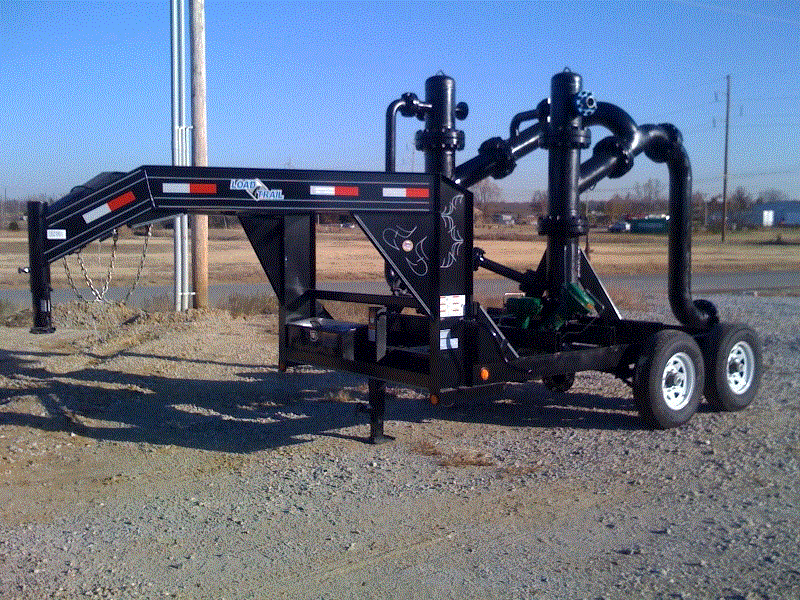|
GLS Separation
The patented Gas-Liquid-Solid (GLS) Separator technology allows the cyclonic separation and/or concentration of gases, liquids and solid particles out of a multi-phase flow stream for further processing and end uses or recirculation. This is important in underbalanced drilling (nitrogen or air) and in post-fracture flow back of gas bearing formations or zones or where gas (CO2 or nitrogen) was used to enhance flow-back and cleanup of the formation.
The GLS Separator is a simple and cost effective solution for drilling and production applications as a fixed or mobile platform. This novel 3-phase compact separator requires minor maintenance and is easy to install and operate over a wide range of applications. The potential applications are:
· Separation system for gas drilling
· Pre-separators
· Sand knockout systems upstream of surface production equipment
The GLS Separator unit can be skid mounted or incorporated on a trailer for fast mobile deployment.
The original cyclonic separation technology was utilized on a 1st generation unit for mobile well testing in a DOE/ Stripper Well Consortium project. That unit was utilized in many fields in northeastern and southern Oklahoma, as well as in southern Illinois. A 3rd Generation GLS Separator was developed via a jointly executed effort by The University of Tulsa and Impact Technologies LLC for the Oklahoma Center for Science and Technology (OCAST). The basic dual separator sizing and layout was prepared by Dr. Shoubo Wang of
In a mobile operation, the trailer mounted unit will be backed up to the well/ drilling rig on the well fluid discharge side of the drilling rig or on a well site. All well return fluids (gas, oil, water, mud and solids) will enter the unit from the back of the trailer at the riser for processing. The liquids and gas resulting from the process can be reused in the drilling process, if so desired. Some of the solids can be size processed and used again, as well. A skid mounted version can also be designed for permanent operation.
The total weight of the trailer version with the separator is approximately 6,000 pounds. While the unit will mostly be operated at only 20-30 psig, it is designed to meet an ANSI 300 rating with controls to allow increased back pressure to manage the well and separation process. This capability also adds safety features for the under-balanced drilling process. Differential pressure sensors are used to monitor and control liquid (and solids) level in both towers by the controlling bottom Fisher liquid valves. Absolute pressure sensors are used to monitor and control pressure via the top Fisher gas valve. The design flow rate of the GLS is up to 3 million SCFPD. Reliability (life, maintenance, failure frequency) and flexibility were also important factors that were considered in the design of the GLS Separator unit.
Table 1
There have been six presentations made at the TUSTP (Tulsa University Separation Technology Projects) semi-annual advisory board meetings and two published MS Thesis regarding the GLS Separator, as well as one final report to Oklahoma Center for the Advancement of Science and Technology (OCAST). Details of these presentations and publications are given below:
1. OCAST Final Project Report, “Novel Gas-Liquid-Solid Separator for Drilling/ Production”, Project No. AR06.1-048 (Contract # 6864), submitted 28 November 2008, by Ram Mohan, Tulsa University Separation Technology Projects.
2. "OCAST Project update: Novel Gas-Liquid-Solid Separator for Drilling/Production” by Ram S. Mohan, 26th Advisory Board Meeting, JIP on Design and Performance of Compact Separators for Multiphase Production Systems - TUSTP, Allen Chapman Activity Center (ACAC), The University of Tulsa, May 16, 2007.
3. "OCAST Project Technical Update: Novel Gas-Liquid-Solid Separator for Drilling/Production” by Rosnayi Arismendi, 26th Advisory Board Meeting, JIP on Design and Performance of Compact Separators for Multiphase Production Systems - TUSTP, Allen Chapman Activity Center (ACAC), The University of Tulsa, May 16, 2007.
4. "OCAST Project Progress Report: Novel Gas-Liquid-Solid Separator for Drilling/Production” by Rosnayi Arismendi, 27th Advisory Board Meeting, JIP on Design and Performance of Compact Separators for Multiphase Production Systems - TUSTP, Allen Chapman Activity Center (ACAC), The University of Tulsa, November 9, 2007.
5. "OCAST Project Progress Report: Novel Gas-Liquid-Solid Separator for Drilling/Production” by Rosnayi Arismendi, 28th Advisory Board Meeting, JIP on Design and Performance of Compact Separators for Multiphase Production Systems - TUSTP, Doubletree Hotel, Tulsa, May 14, 2008.
6. "Utilization of Gas-Liquid Cylindrical Cyclone Compact (GLCC©) Separator for Solid Removal in Gas Drilling Systems” by Rosnayi Arismendi, 29th Advisory Board Meeting, JIP on Design and Performance of Compact Separators for Multiphase Production Systems - TUSTP, Doubletree Hotel, Tulsa, November 19, 2008.
7. "Operational Envelope for Carry -Over for Gas-Liquid-Solid Flow in GLCC©” by Serik Omarov, 29th Advisory Board Meeting, JIP on Design and Performance of Compact Separators for Multiphase Production Systems - TUSTP, Doubletree Hotel, Tulsa, November 19, 2008.
8. "Utilization of Gas-Liquid Cylindrical Cyclone Compact (GLCC©) Separator for Solid Removal in Gas Drilling Systems” Rosnayi Arismendi, M.S. Thesis, The University of Tulsa, 2008.
9. “Operational Envelope for Carry -Over for Gas-Liquid-Solid Flow in GLCC©”, Serik Omarov, M.S. Thesis, The University of Tulsa, 2008.
|

